Chocolate Industry: Business and Strategic Management Analysis
VerifiedAdded on 2023/06/14
|9
|2226
|446
Report
AI Summary
This report provides a comprehensive analysis of the chocolate industry, focusing on business and strategic management aspects. It begins with a PESTLE analysis of key cocoa-producing countries like Côte d'Ivoire, Indonesia, and the Dominican Republic, examining the political, economic, social, technological, legal, and environmental factors impacting cocoa production. The report then shifts to an analysis of Hershey's market positioning, employing Porter's Five Forces to assess the competitive landscape, including the threat of new entrants, bargaining power of suppliers and buyers, the threat of substitution, and the intensity of rivalry. The study highlights the challenges and opportunities within the chocolate industry, providing valuable insights into strategic decision-making for companies operating in this sector. Desklib offers a wealth of similar resources, including past papers and solved assignments, to aid students in their studies.
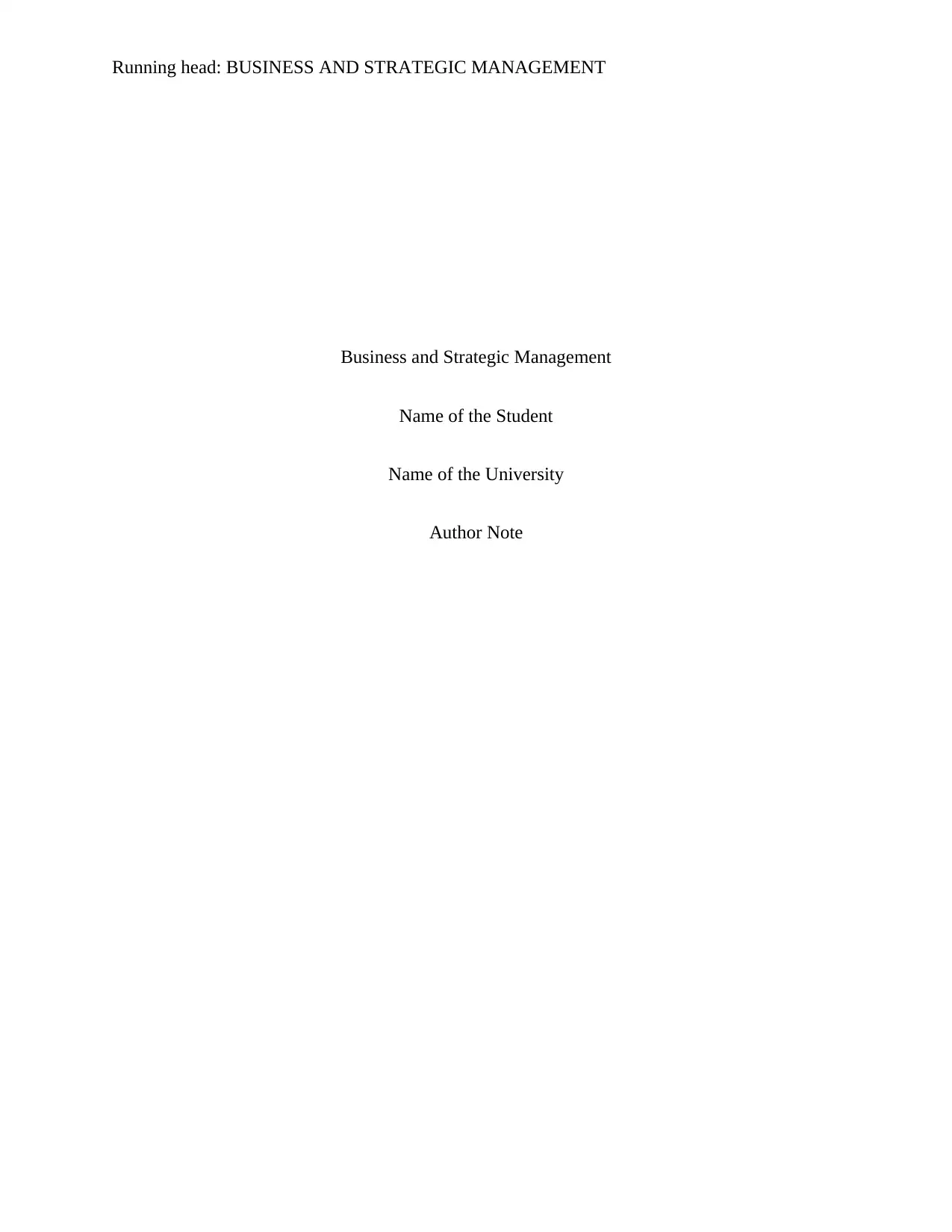
Running head: BUSINESS AND STRATEGIC MANAGEMENT
Business and Strategic Management
Name of the Student
Name of the University
Author Note
Business and Strategic Management
Name of the Student
Name of the University
Author Note
Paraphrase This Document
Need a fresh take? Get an instant paraphrase of this document with our AI Paraphraser
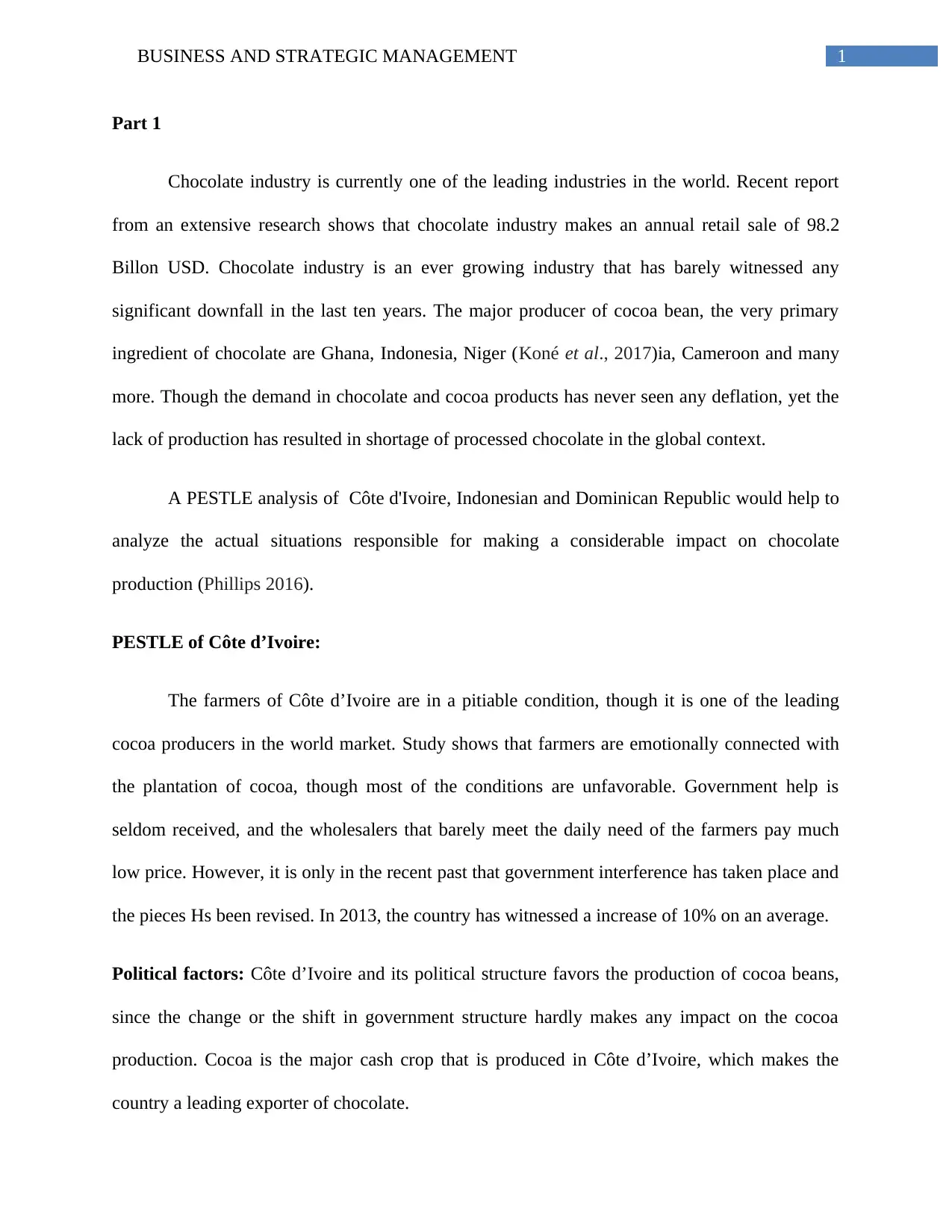
1BUSINESS AND STRATEGIC MANAGEMENT
Part 1
Chocolate industry is currently one of the leading industries in the world. Recent report
from an extensive research shows that chocolate industry makes an annual retail sale of 98.2
Billon USD. Chocolate industry is an ever growing industry that has barely witnessed any
significant downfall in the last ten years. The major producer of cocoa bean, the very primary
ingredient of chocolate are Ghana, Indonesia, Niger (Koné et al., 2017)ia, Cameroon and many
more. Though the demand in chocolate and cocoa products has never seen any deflation, yet the
lack of production has resulted in shortage of processed chocolate in the global context.
A PESTLE analysis of Côte d'Ivoire, Indonesian and Dominican Republic would help to
analyze the actual situations responsible for making a considerable impact on chocolate
production (Phillips 2016).
PESTLE of Côte d’Ivoire:
The farmers of Côte d’Ivoire are in a pitiable condition, though it is one of the leading
cocoa producers in the world market. Study shows that farmers are emotionally connected with
the plantation of cocoa, though most of the conditions are unfavorable. Government help is
seldom received, and the wholesalers that barely meet the daily need of the farmers pay much
low price. However, it is only in the recent past that government interference has taken place and
the pieces Hs been revised. In 2013, the country has witnessed a increase of 10% on an average.
Political factors: Côte d’Ivoire and its political structure favors the production of cocoa beans,
since the change or the shift in government structure hardly makes any impact on the cocoa
production. Cocoa is the major cash crop that is produced in Côte d’Ivoire, which makes the
country a leading exporter of chocolate.
Part 1
Chocolate industry is currently one of the leading industries in the world. Recent report
from an extensive research shows that chocolate industry makes an annual retail sale of 98.2
Billon USD. Chocolate industry is an ever growing industry that has barely witnessed any
significant downfall in the last ten years. The major producer of cocoa bean, the very primary
ingredient of chocolate are Ghana, Indonesia, Niger (Koné et al., 2017)ia, Cameroon and many
more. Though the demand in chocolate and cocoa products has never seen any deflation, yet the
lack of production has resulted in shortage of processed chocolate in the global context.
A PESTLE analysis of Côte d'Ivoire, Indonesian and Dominican Republic would help to
analyze the actual situations responsible for making a considerable impact on chocolate
production (Phillips 2016).
PESTLE of Côte d’Ivoire:
The farmers of Côte d’Ivoire are in a pitiable condition, though it is one of the leading
cocoa producers in the world market. Study shows that farmers are emotionally connected with
the plantation of cocoa, though most of the conditions are unfavorable. Government help is
seldom received, and the wholesalers that barely meet the daily need of the farmers pay much
low price. However, it is only in the recent past that government interference has taken place and
the pieces Hs been revised. In 2013, the country has witnessed a increase of 10% on an average.
Political factors: Côte d’Ivoire and its political structure favors the production of cocoa beans,
since the change or the shift in government structure hardly makes any impact on the cocoa
production. Cocoa is the major cash crop that is produced in Côte d’Ivoire, which makes the
country a leading exporter of chocolate.
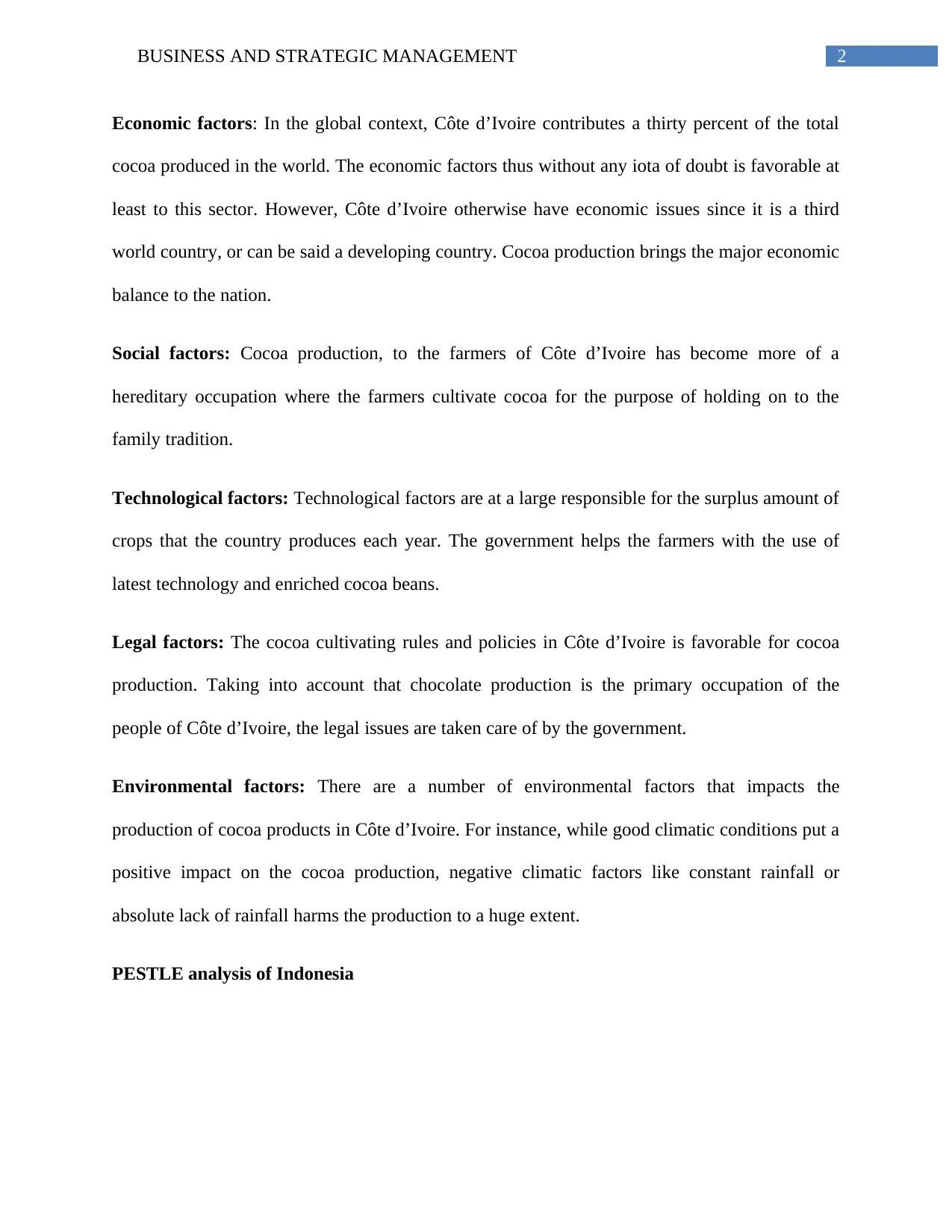
2BUSINESS AND STRATEGIC MANAGEMENT
Economic factors: In the global context, Côte d’Ivoire contributes a thirty percent of the total
cocoa produced in the world. The economic factors thus without any iota of doubt is favorable at
least to this sector. However, Côte d’Ivoire otherwise have economic issues since it is a third
world country, or can be said a developing country. Cocoa production brings the major economic
balance to the nation.
Social factors: Cocoa production, to the farmers of Côte d’Ivoire has become more of a
hereditary occupation where the farmers cultivate cocoa for the purpose of holding on to the
family tradition.
Technological factors: Technological factors are at a large responsible for the surplus amount of
crops that the country produces each year. The government helps the farmers with the use of
latest technology and enriched cocoa beans.
Legal factors: The cocoa cultivating rules and policies in Côte d’Ivoire is favorable for cocoa
production. Taking into account that chocolate production is the primary occupation of the
people of Côte d’Ivoire, the legal issues are taken care of by the government.
Environmental factors: There are a number of environmental factors that impacts the
production of cocoa products in Côte d’Ivoire. For instance, while good climatic conditions put a
positive impact on the cocoa production, negative climatic factors like constant rainfall or
absolute lack of rainfall harms the production to a huge extent.
PESTLE analysis of Indonesia
Economic factors: In the global context, Côte d’Ivoire contributes a thirty percent of the total
cocoa produced in the world. The economic factors thus without any iota of doubt is favorable at
least to this sector. However, Côte d’Ivoire otherwise have economic issues since it is a third
world country, or can be said a developing country. Cocoa production brings the major economic
balance to the nation.
Social factors: Cocoa production, to the farmers of Côte d’Ivoire has become more of a
hereditary occupation where the farmers cultivate cocoa for the purpose of holding on to the
family tradition.
Technological factors: Technological factors are at a large responsible for the surplus amount of
crops that the country produces each year. The government helps the farmers with the use of
latest technology and enriched cocoa beans.
Legal factors: The cocoa cultivating rules and policies in Côte d’Ivoire is favorable for cocoa
production. Taking into account that chocolate production is the primary occupation of the
people of Côte d’Ivoire, the legal issues are taken care of by the government.
Environmental factors: There are a number of environmental factors that impacts the
production of cocoa products in Côte d’Ivoire. For instance, while good climatic conditions put a
positive impact on the cocoa production, negative climatic factors like constant rainfall or
absolute lack of rainfall harms the production to a huge extent.
PESTLE analysis of Indonesia
⊘ This is a preview!⊘
Do you want full access?
Subscribe today to unlock all pages.

Trusted by 1+ million students worldwide
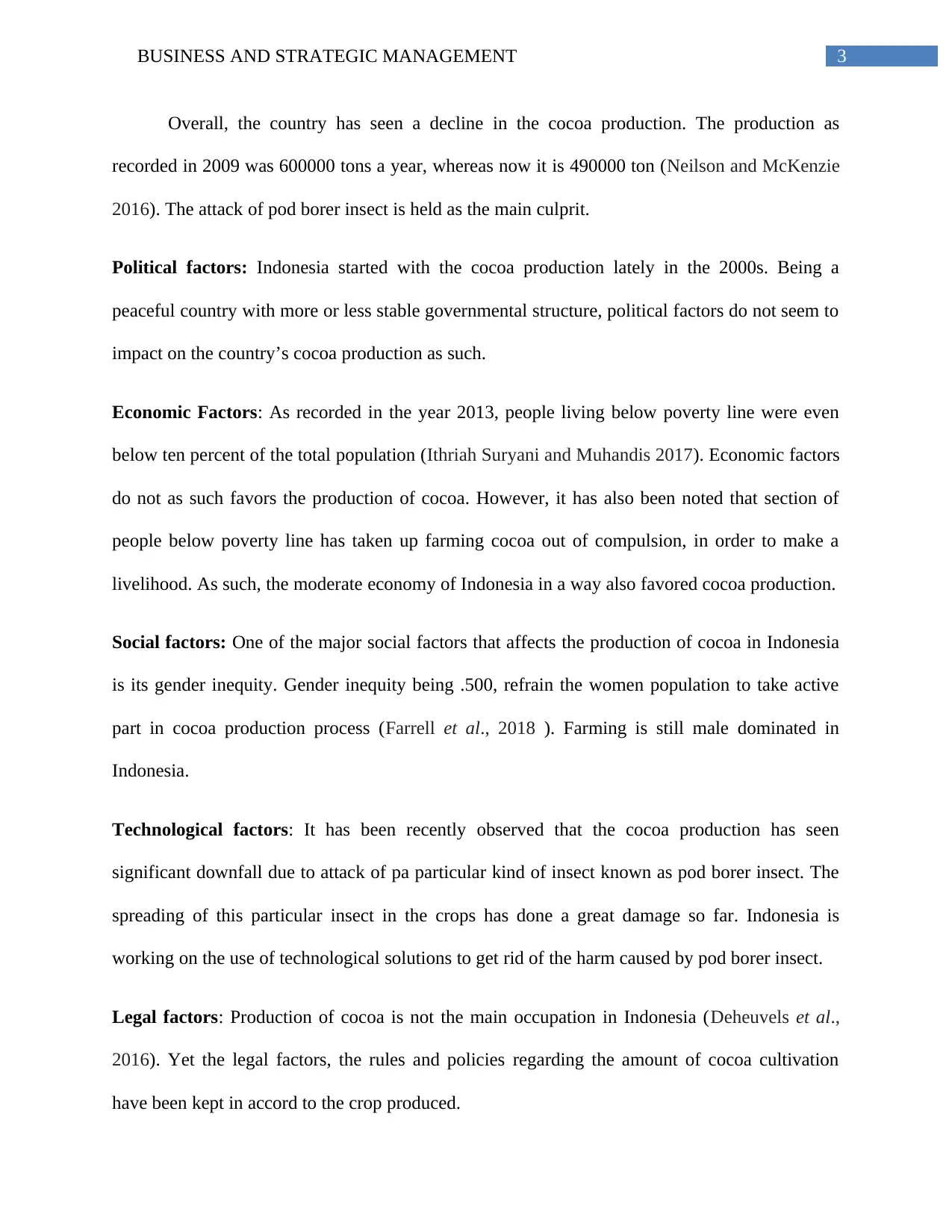
3BUSINESS AND STRATEGIC MANAGEMENT
Overall, the country has seen a decline in the cocoa production. The production as
recorded in 2009 was 600000 tons a year, whereas now it is 490000 ton (Neilson and McKenzie
2016). The attack of pod borer insect is held as the main culprit.
Political factors: Indonesia started with the cocoa production lately in the 2000s. Being a
peaceful country with more or less stable governmental structure, political factors do not seem to
impact on the country’s cocoa production as such.
Economic Factors: As recorded in the year 2013, people living below poverty line were even
below ten percent of the total population (Ithriah Suryani and Muhandis 2017). Economic factors
do not as such favors the production of cocoa. However, it has also been noted that section of
people below poverty line has taken up farming cocoa out of compulsion, in order to make a
livelihood. As such, the moderate economy of Indonesia in a way also favored cocoa production.
Social factors: One of the major social factors that affects the production of cocoa in Indonesia
is its gender inequity. Gender inequity being .500, refrain the women population to take active
part in cocoa production process (Farrell et al., 2018 ). Farming is still male dominated in
Indonesia.
Technological factors: It has been recently observed that the cocoa production has seen
significant downfall due to attack of pa particular kind of insect known as pod borer insect. The
spreading of this particular insect in the crops has done a great damage so far. Indonesia is
working on the use of technological solutions to get rid of the harm caused by pod borer insect.
Legal factors: Production of cocoa is not the main occupation in Indonesia (Deheuvels et al.,
2016). Yet the legal factors, the rules and policies regarding the amount of cocoa cultivation
have been kept in accord to the crop produced.
Overall, the country has seen a decline in the cocoa production. The production as
recorded in 2009 was 600000 tons a year, whereas now it is 490000 ton (Neilson and McKenzie
2016). The attack of pod borer insect is held as the main culprit.
Political factors: Indonesia started with the cocoa production lately in the 2000s. Being a
peaceful country with more or less stable governmental structure, political factors do not seem to
impact on the country’s cocoa production as such.
Economic Factors: As recorded in the year 2013, people living below poverty line were even
below ten percent of the total population (Ithriah Suryani and Muhandis 2017). Economic factors
do not as such favors the production of cocoa. However, it has also been noted that section of
people below poverty line has taken up farming cocoa out of compulsion, in order to make a
livelihood. As such, the moderate economy of Indonesia in a way also favored cocoa production.
Social factors: One of the major social factors that affects the production of cocoa in Indonesia
is its gender inequity. Gender inequity being .500, refrain the women population to take active
part in cocoa production process (Farrell et al., 2018 ). Farming is still male dominated in
Indonesia.
Technological factors: It has been recently observed that the cocoa production has seen
significant downfall due to attack of pa particular kind of insect known as pod borer insect. The
spreading of this particular insect in the crops has done a great damage so far. Indonesia is
working on the use of technological solutions to get rid of the harm caused by pod borer insect.
Legal factors: Production of cocoa is not the main occupation in Indonesia (Deheuvels et al.,
2016). Yet the legal factors, the rules and policies regarding the amount of cocoa cultivation
have been kept in accord to the crop produced.
Paraphrase This Document
Need a fresh take? Get an instant paraphrase of this document with our AI Paraphraser

4BUSINESS AND STRATEGIC MANAGEMENT
Environmental factors: Environmental factors are soothing towards the cultivation of cocoa in
large scale. However, necessary steps have been taken so that environmental factors and its
corresponding ill effects can be curbed for better production of cocoa crops.
PESTLE of Dominican Republic:
Considering the geographical area that the country holds, the production of cocoa is
surplus. The country grows near about 70,000 tons of high quality cocoa each year that are fully
organic and holds fine flavor (Omsa, Abdullah and Jamali 2017). Having a total population of
350000 in the country, 40,000 and above are engaged with the production of cocoa.
Political factors: As far as the production of cocoa are concerned, it does not have any impact
on the production of cocoa. The stability or the under stability of the political conditions hardly
influences cocoa production, since, it is the primary cash crop produced in Dominican Republic.
Economic Factors: Economic factors have been favorable in the context of cocoa production in
Dominican Republic. Since cocoa is the major cash crop that is produced in the country, the
economy of the country largely depends on the production of cocoa. The country employs over
40,000 farmers exclusively for cocoa production (Notaro et al., 2017).
Social factors: Since cocoa is cultivated as the primary cash crop, the farmers in Dominican
Republic own their own land for farming. There is seldom land taken at lease by the farmers as
most of them own their own land. This also has a negative impact. There is less chance for
further flourish in the production.
Environmental factors: Environmental factors are soothing towards the cultivation of cocoa in
large scale. However, necessary steps have been taken so that environmental factors and its
corresponding ill effects can be curbed for better production of cocoa crops.
PESTLE of Dominican Republic:
Considering the geographical area that the country holds, the production of cocoa is
surplus. The country grows near about 70,000 tons of high quality cocoa each year that are fully
organic and holds fine flavor (Omsa, Abdullah and Jamali 2017). Having a total population of
350000 in the country, 40,000 and above are engaged with the production of cocoa.
Political factors: As far as the production of cocoa are concerned, it does not have any impact
on the production of cocoa. The stability or the under stability of the political conditions hardly
influences cocoa production, since, it is the primary cash crop produced in Dominican Republic.
Economic Factors: Economic factors have been favorable in the context of cocoa production in
Dominican Republic. Since cocoa is the major cash crop that is produced in the country, the
economy of the country largely depends on the production of cocoa. The country employs over
40,000 farmers exclusively for cocoa production (Notaro et al., 2017).
Social factors: Since cocoa is cultivated as the primary cash crop, the farmers in Dominican
Republic own their own land for farming. There is seldom land taken at lease by the farmers as
most of them own their own land. This also has a negative impact. There is less chance for
further flourish in the production.
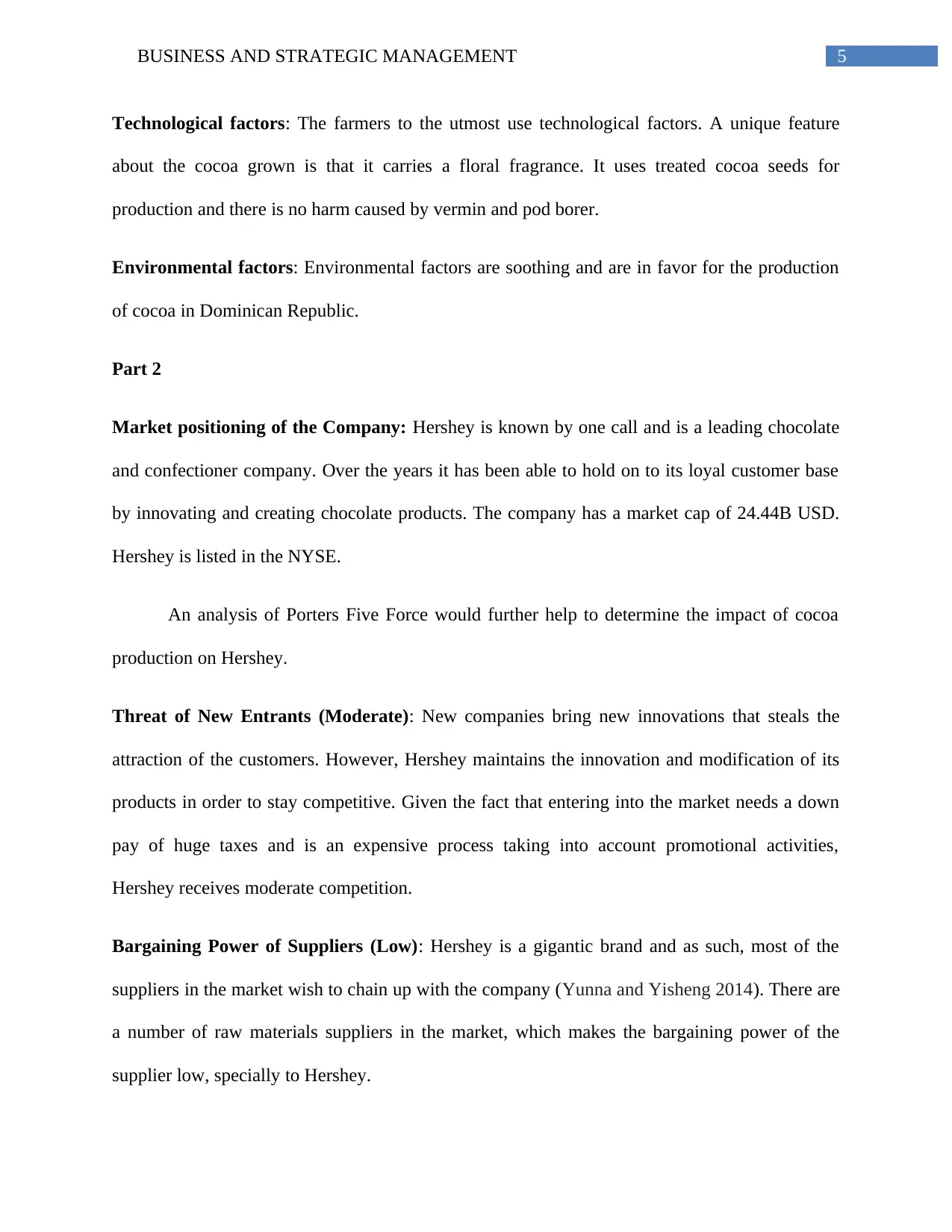
5BUSINESS AND STRATEGIC MANAGEMENT
Technological factors: The farmers to the utmost use technological factors. A unique feature
about the cocoa grown is that it carries a floral fragrance. It uses treated cocoa seeds for
production and there is no harm caused by vermin and pod borer.
Environmental factors: Environmental factors are soothing and are in favor for the production
of cocoa in Dominican Republic.
Part 2
Market positioning of the Company: Hershey is known by one call and is a leading chocolate
and confectioner company. Over the years it has been able to hold on to its loyal customer base
by innovating and creating chocolate products. The company has a market cap of 24.44B USD.
Hershey is listed in the NYSE.
An analysis of Porters Five Force would further help to determine the impact of cocoa
production on Hershey.
Threat of New Entrants (Moderate): New companies bring new innovations that steals the
attraction of the customers. However, Hershey maintains the innovation and modification of its
products in order to stay competitive. Given the fact that entering into the market needs a down
pay of huge taxes and is an expensive process taking into account promotional activities,
Hershey receives moderate competition.
Bargaining Power of Suppliers (Low): Hershey is a gigantic brand and as such, most of the
suppliers in the market wish to chain up with the company (Yunna and Yisheng 2014). There are
a number of raw materials suppliers in the market, which makes the bargaining power of the
supplier low, specially to Hershey.
Technological factors: The farmers to the utmost use technological factors. A unique feature
about the cocoa grown is that it carries a floral fragrance. It uses treated cocoa seeds for
production and there is no harm caused by vermin and pod borer.
Environmental factors: Environmental factors are soothing and are in favor for the production
of cocoa in Dominican Republic.
Part 2
Market positioning of the Company: Hershey is known by one call and is a leading chocolate
and confectioner company. Over the years it has been able to hold on to its loyal customer base
by innovating and creating chocolate products. The company has a market cap of 24.44B USD.
Hershey is listed in the NYSE.
An analysis of Porters Five Force would further help to determine the impact of cocoa
production on Hershey.
Threat of New Entrants (Moderate): New companies bring new innovations that steals the
attraction of the customers. However, Hershey maintains the innovation and modification of its
products in order to stay competitive. Given the fact that entering into the market needs a down
pay of huge taxes and is an expensive process taking into account promotional activities,
Hershey receives moderate competition.
Bargaining Power of Suppliers (Low): Hershey is a gigantic brand and as such, most of the
suppliers in the market wish to chain up with the company (Yunna and Yisheng 2014). There are
a number of raw materials suppliers in the market, which makes the bargaining power of the
supplier low, specially to Hershey.
⊘ This is a preview!⊘
Do you want full access?
Subscribe today to unlock all pages.

Trusted by 1+ million students worldwide
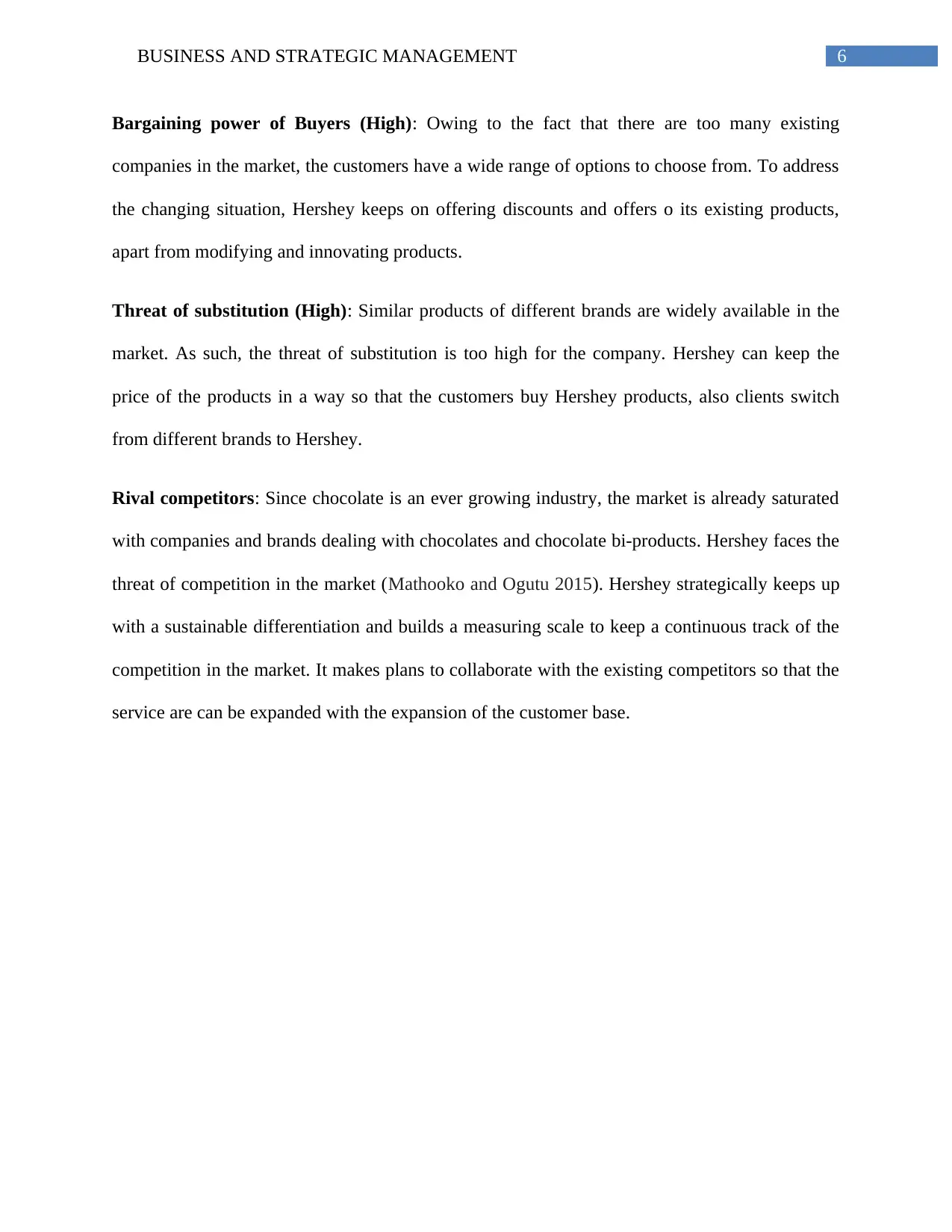
6BUSINESS AND STRATEGIC MANAGEMENT
Bargaining power of Buyers (High): Owing to the fact that there are too many existing
companies in the market, the customers have a wide range of options to choose from. To address
the changing situation, Hershey keeps on offering discounts and offers o its existing products,
apart from modifying and innovating products.
Threat of substitution (High): Similar products of different brands are widely available in the
market. As such, the threat of substitution is too high for the company. Hershey can keep the
price of the products in a way so that the customers buy Hershey products, also clients switch
from different brands to Hershey.
Rival competitors: Since chocolate is an ever growing industry, the market is already saturated
with companies and brands dealing with chocolates and chocolate bi-products. Hershey faces the
threat of competition in the market (Mathooko and Ogutu 2015). Hershey strategically keeps up
with a sustainable differentiation and builds a measuring scale to keep a continuous track of the
competition in the market. It makes plans to collaborate with the existing competitors so that the
service are can be expanded with the expansion of the customer base.
Bargaining power of Buyers (High): Owing to the fact that there are too many existing
companies in the market, the customers have a wide range of options to choose from. To address
the changing situation, Hershey keeps on offering discounts and offers o its existing products,
apart from modifying and innovating products.
Threat of substitution (High): Similar products of different brands are widely available in the
market. As such, the threat of substitution is too high for the company. Hershey can keep the
price of the products in a way so that the customers buy Hershey products, also clients switch
from different brands to Hershey.
Rival competitors: Since chocolate is an ever growing industry, the market is already saturated
with companies and brands dealing with chocolates and chocolate bi-products. Hershey faces the
threat of competition in the market (Mathooko and Ogutu 2015). Hershey strategically keeps up
with a sustainable differentiation and builds a measuring scale to keep a continuous track of the
competition in the market. It makes plans to collaborate with the existing competitors so that the
service are can be expanded with the expansion of the customer base.
Paraphrase This Document
Need a fresh take? Get an instant paraphrase of this document with our AI Paraphraser
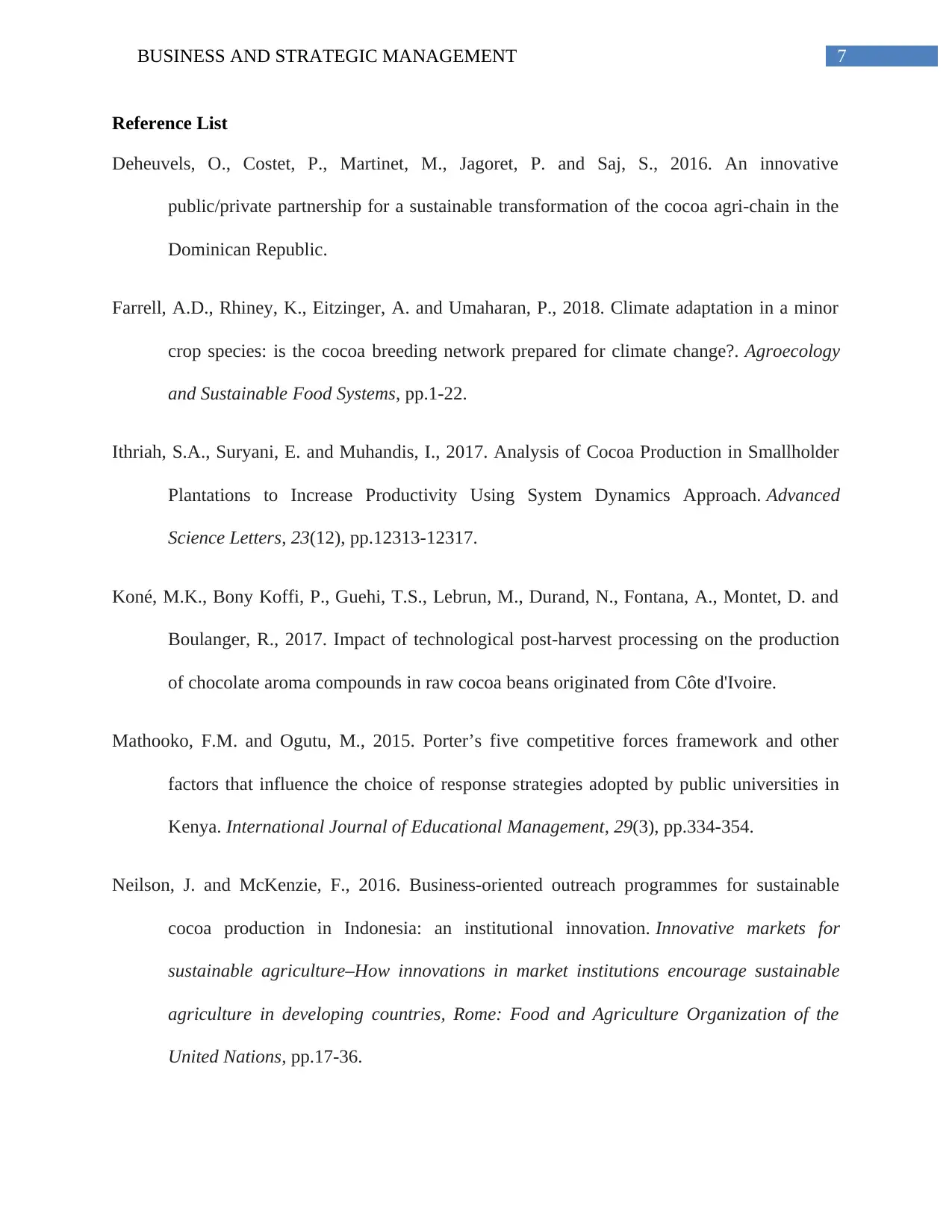
7BUSINESS AND STRATEGIC MANAGEMENT
Reference List
Deheuvels, O., Costet, P., Martinet, M., Jagoret, P. and Saj, S., 2016. An innovative
public/private partnership for a sustainable transformation of the cocoa agri-chain in the
Dominican Republic.
Farrell, A.D., Rhiney, K., Eitzinger, A. and Umaharan, P., 2018. Climate adaptation in a minor
crop species: is the cocoa breeding network prepared for climate change?. Agroecology
and Sustainable Food Systems, pp.1-22.
Ithriah, S.A., Suryani, E. and Muhandis, I., 2017. Analysis of Cocoa Production in Smallholder
Plantations to Increase Productivity Using System Dynamics Approach. Advanced
Science Letters, 23(12), pp.12313-12317.
Koné, M.K., Bony Koffi, P., Guehi, T.S., Lebrun, M., Durand, N., Fontana, A., Montet, D. and
Boulanger, R., 2017. Impact of technological post-harvest processing on the production
of chocolate aroma compounds in raw cocoa beans originated from Côte d'Ivoire.
Mathooko, F.M. and Ogutu, M., 2015. Porter’s five competitive forces framework and other
factors that influence the choice of response strategies adopted by public universities in
Kenya. International Journal of Educational Management, 29(3), pp.334-354.
Neilson, J. and McKenzie, F., 2016. Business-oriented outreach programmes for sustainable
cocoa production in Indonesia: an institutional innovation. Innovative markets for
sustainable agriculture–How innovations in market institutions encourage sustainable
agriculture in developing countries, Rome: Food and Agriculture Organization of the
United Nations, pp.17-36.
Reference List
Deheuvels, O., Costet, P., Martinet, M., Jagoret, P. and Saj, S., 2016. An innovative
public/private partnership for a sustainable transformation of the cocoa agri-chain in the
Dominican Republic.
Farrell, A.D., Rhiney, K., Eitzinger, A. and Umaharan, P., 2018. Climate adaptation in a minor
crop species: is the cocoa breeding network prepared for climate change?. Agroecology
and Sustainable Food Systems, pp.1-22.
Ithriah, S.A., Suryani, E. and Muhandis, I., 2017. Analysis of Cocoa Production in Smallholder
Plantations to Increase Productivity Using System Dynamics Approach. Advanced
Science Letters, 23(12), pp.12313-12317.
Koné, M.K., Bony Koffi, P., Guehi, T.S., Lebrun, M., Durand, N., Fontana, A., Montet, D. and
Boulanger, R., 2017. Impact of technological post-harvest processing on the production
of chocolate aroma compounds in raw cocoa beans originated from Côte d'Ivoire.
Mathooko, F.M. and Ogutu, M., 2015. Porter’s five competitive forces framework and other
factors that influence the choice of response strategies adopted by public universities in
Kenya. International Journal of Educational Management, 29(3), pp.334-354.
Neilson, J. and McKenzie, F., 2016. Business-oriented outreach programmes for sustainable
cocoa production in Indonesia: an institutional innovation. Innovative markets for
sustainable agriculture–How innovations in market institutions encourage sustainable
agriculture in developing countries, Rome: Food and Agriculture Organization of the
United Nations, pp.17-36.
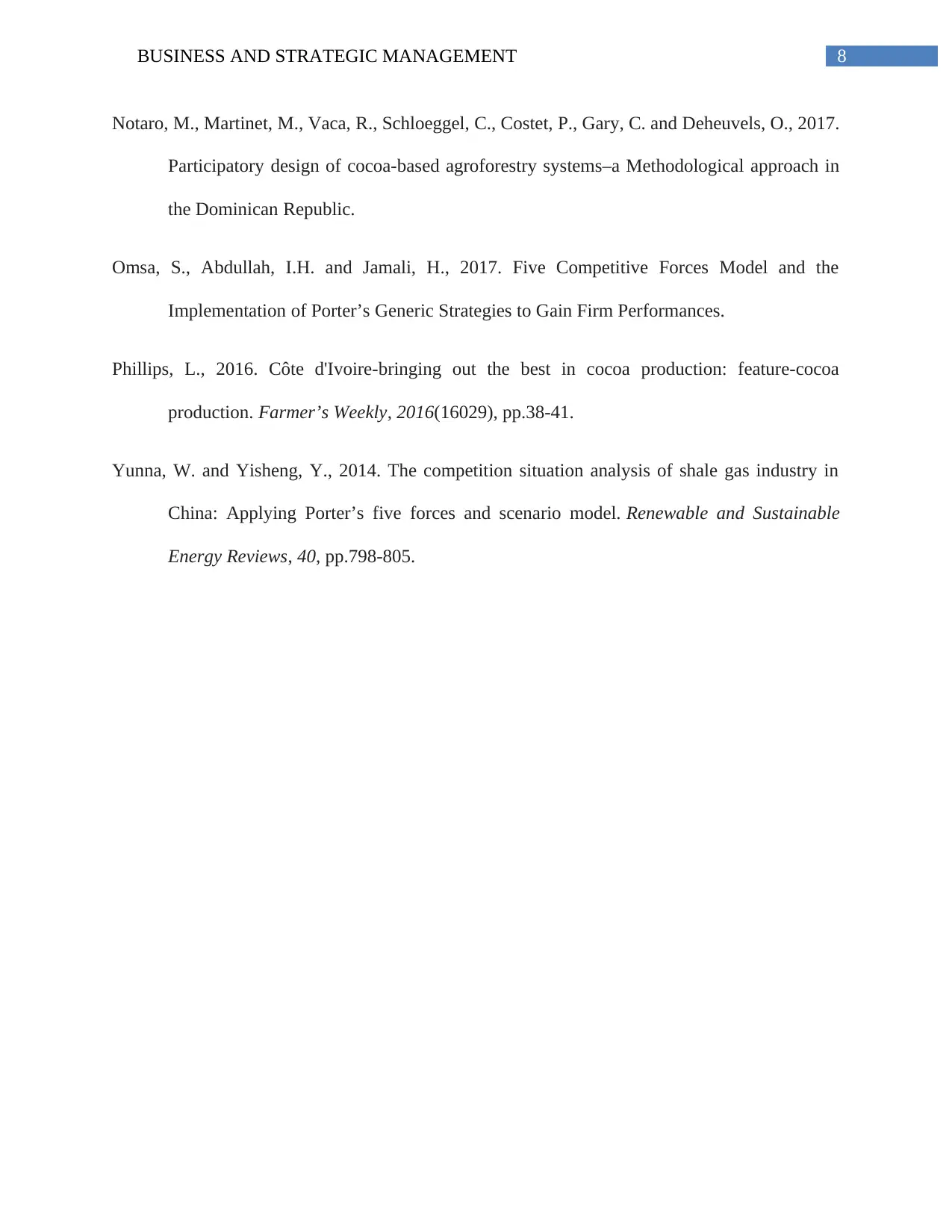
8BUSINESS AND STRATEGIC MANAGEMENT
Notaro, M., Martinet, M., Vaca, R., Schloeggel, C., Costet, P., Gary, C. and Deheuvels, O., 2017.
Participatory design of cocoa-based agroforestry systems–a Methodological approach in
the Dominican Republic.
Omsa, S., Abdullah, I.H. and Jamali, H., 2017. Five Competitive Forces Model and the
Implementation of Porter’s Generic Strategies to Gain Firm Performances.
Phillips, L., 2016. Côte d'Ivoire-bringing out the best in cocoa production: feature-cocoa
production. Farmer’s Weekly, 2016(16029), pp.38-41.
Yunna, W. and Yisheng, Y., 2014. The competition situation analysis of shale gas industry in
China: Applying Porter’s five forces and scenario model. Renewable and Sustainable
Energy Reviews, 40, pp.798-805.
Notaro, M., Martinet, M., Vaca, R., Schloeggel, C., Costet, P., Gary, C. and Deheuvels, O., 2017.
Participatory design of cocoa-based agroforestry systems–a Methodological approach in
the Dominican Republic.
Omsa, S., Abdullah, I.H. and Jamali, H., 2017. Five Competitive Forces Model and the
Implementation of Porter’s Generic Strategies to Gain Firm Performances.
Phillips, L., 2016. Côte d'Ivoire-bringing out the best in cocoa production: feature-cocoa
production. Farmer’s Weekly, 2016(16029), pp.38-41.
Yunna, W. and Yisheng, Y., 2014. The competition situation analysis of shale gas industry in
China: Applying Porter’s five forces and scenario model. Renewable and Sustainable
Energy Reviews, 40, pp.798-805.
⊘ This is a preview!⊘
Do you want full access?
Subscribe today to unlock all pages.

Trusted by 1+ million students worldwide
1 out of 9
Related Documents
Your All-in-One AI-Powered Toolkit for Academic Success.
+13062052269
info@desklib.com
Available 24*7 on WhatsApp / Email
![[object Object]](/_next/static/media/star-bottom.7253800d.svg)
Unlock your academic potential
Copyright © 2020–2025 A2Z Services. All Rights Reserved. Developed and managed by ZUCOL.





